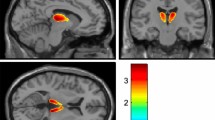Summary.
We report a case of a 74-year old woman who following an acute virus encephalitis developed an akinetic-rigid Parkinson syndrome with tremor, hypokinesia, hypomimia, rigidity and cogwheel phenomenon in all four extremities, brady-dysdiadochokinesia as well as myoclonic jerks of the arms. Many of the clinical features of this postencephalitic parkinsonism (PEP) suggested the diagnosis of sporadic encephalitis lethargica, first described by von Economo 1917. Cerebral spinal fluid showed signs of a viral encephalitis, and a positive influenza A IgA-antibody titer (1 : >160) in the viral serologic screen was found. Positron emission tomography (PET) showed an altered pattern of glucose- and dopa-metabolism clearly different from findings in idiopathic Parkinson syndrome (IPS). The acute lack of inhibitory input from the substantia nigra pars compacta to the striatum could explain the different metabolic patterns in our case in comparison to IPS patients. Our findings indicate that PEP may also be caused by influenza A and furthermore that PET clearly distinguishes PEP from IPS.
Similar content being viewed by others
Author information
Authors and Affiliations
Additional information
Received January 27, 2000; accepted March 29, 2000
Rights and permissions
About this article
Cite this article
Ghaemi, M., Rudolf, J., Schmülling, S. et al. FDG- and Dopa-PET in postencephalitic parkinsonism. J Neural Transm 107, 1289–1295 (2000). https://doi.org/10.1007/s007020070018
Issue Date:
DOI: https://doi.org/10.1007/s007020070018




